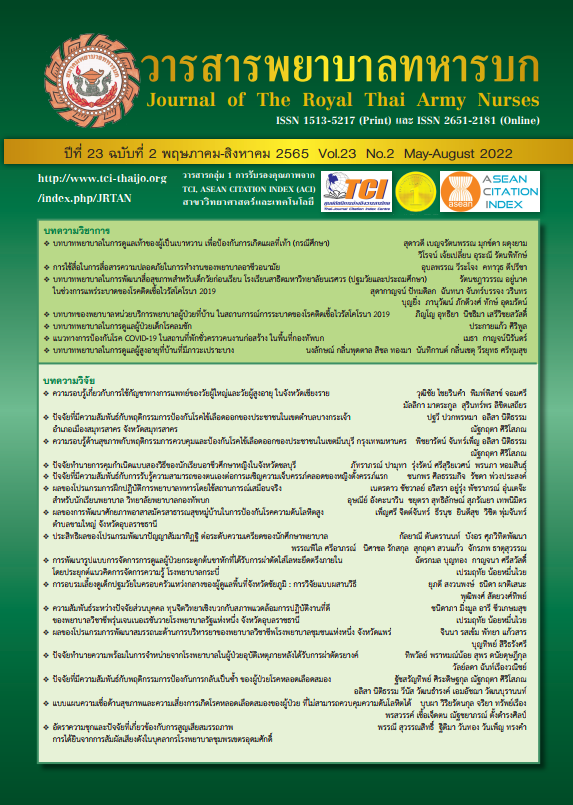Factors Predicting Traumatic Patients Readiness for Hospital Discharge after Extremity Surgery
Keywords:
traumatic patients after extremity surgery, meaning of illness, health literacy, length of stay, readiness for hospital dischargeAbstract
This study is a predictive correlation aimed to study is to investigate factors influencing Readiness for hospital discharge to home. By using transition theory. The sample total is 75 traumatic patients after extremity surgery, who were admitted at the Phrachomklao, Phetchaburi Hospital. The instruments used for data collection were the personal data questionnaire, the Brief Illness Perception Questionnaire, the Health literacy Questionnaire, and The Brief PREPARED. Statistical analysis using multiple regression.
The results, found that Age, Length of stay, Meaning of Illness, and Health literacy predicted readiness for hospital discharge, 51.8 of traumatic patients after extremity surgery showed statistically significant results (R2 = .518, F = 18.829, p < .05). The factor that can predict the readiness for hospital discharge with the highest statistical significance was health literacy (β = .434, p < .001), followed by the meaning of illness (β = -.296, p < .01) and length of stay (β = -.231, p = .01), respectively. The research results can be developed into a nursing program or model. To improve the quality of care for Traumatic patients after extremity surgery. Enabling patients can self-care themselves effectively, lead to well-being.
Downloads
References
Kohler RE, Tomlinson J, Chilunjika TE, Young S, Hosseinipour M, Lee CN. “Life is at a standstill” Quality of life after lower extremity trauma in Malawi. Quality of Life Research. 2017; 26(4):1027-1035.
Tiruneh C, Seyoum G, Regasa G, Lambisso B. Clinical profile and patterns of extremity fractures in orthopedics department in tikur anbessa specialized hospital. Ethiopian Medical Journal. 2020;58(2):159-165.
World Health Organization. GLOBAL STATUS REPORT ON ROAD SAFETY 2018. Geneva: World Health Organization; 2018.
Pundee J, Chayaput P, Chanruangvanich W, Wannatoop T. Predictors of Functional Restoration in Extremity Injury Patients. Journal of Thailand Nursing and Midwifery Council. 2019;34(4):48-63. (in Thai)
Bouyer B, Leroy F, Rudant J, Weill A, Coste J. Burden of fractures in France: incidence and severity by age, gender, and site in 2016. International Orthopaedics. 2020;44(5): 947-955.
Zdziarski HL, Vasilopoulos T, Horodyski M, Hagen JE, Sadasivan KS, Sharififar S, et al. Can an Integrative Care Approach Improve Phys ical Function Trajector ies after Orthopaedic Trauma? A Randomized Controlled Trial. Clinical Orthopaedics and Related Research. 2020;478(4):792-804.
Meleis AI. Transitions theory: middle-range and situation-specific theories in nursing research and practice. New York: Springer Publishing Company; 2010.
Coffey A, McCarthy GM. Older people’s perception of their readiness for discharge and postdischarge use of community support and services. International Journal of Older People Nursing. 2013;8(2):104-115.
Moosiri S, Samartkit N, Tanatwanit Y. Factors related to discharge readiness in patients with closed fracture of a leg undergoing internal fixation surgery. (thesis). Chonburi: Burapha University; 2013. (in Thai)
Brotemarkle RA, Resnick B, Michaels K, Morton P, Wells C. Length of hospital stay and discharge disposition in older trauma patients. Geriatric Nursing. 2015;36 (2 Suppl): S3-9.
Halawi MJ, Vovos TJ, Green CL, Wellman SS, Attarian DE, Bolognesi MP. Patient expectation is the most important predictor of discharge destination after primary total joint arthroplasty. The Journal of Arthroplasty. 2015;30(4):539-542.
Ilona K, Jurgen MP, Franklin A, Agis DT, editors. Health literacy the solid facts. Denmark: WHO Regional Office for Europe; 2013.
Wallace AS, Perkhounkova Y, Bohr NL, Chung SJ. Readiness for Hospital Discharge, Health Literacy, and Social Living Status. Clinical Nursing Research. 2016; 25(5):494-511.
Koponrat K., Danaidutsadeekul S., Wanitkul N., & Narkbunnum R. Predictors of Quality of Life among Osteoarthritis Patients after Knee Arthroplasty. Journal of Nursing Science. 2017; 35(3): 94-105. (in Thai)
Broadbent E, Petrie KJ, Main J, Weinman J. The Brief Illness Perception Questionnaire. Journal of Psychosomatic Research. 2006; 60(6):631-637.
Sowattanangoon N, Kotchabhakdi N, Petrie KJ. The influence of Thai culture on diabetes perceptions and management. Diabetes Research and Clinical Practice. 2009; 84(3): 245-251. (in Thai)
Wanitkul N, Pattaramongkolrit S, Vichathai C, Petchrung B, Kloyaium S, Batterham R, et al. Health literacy in Thai people. Nonthaburi: Health Systems Research Institute; 2014. (in Thai).
Graumlich JF, Novotny NL, Aldag JC. Brief scale measuring patient preparedness for hospital discharge to home: Psychometric properties. Journal of Hospital Medicine 2008; 3(6): 446-454.
Khorgami Z, Ewing KL, Mushtaq N, Chow GS, Howard CA. Predictors of discharge destination in patients with major traumatic injury: Analysis of Oklahoma Trauma Registry. The American Journal of Surgery. 2019;218(3): 496-500.
Shuzhen C, Yen Peng Neo A, Suxin Chen L, Yee Lin Seah E, Chi Ling L, Nay Linn A, et al. Understanding factors influencing the choice of discharge destination by older patients post total lower limb replacement: A qualitative study. Proceedings of Singapore Healthcare. 2016;25(1):43-49.
Kumdech P, Jitramontree N, Wirojratana V, Thosingha O. Predicting Factors on Functional Recovery Post Operative Hip Fracture in Older Persons. J Royal Thai Army Nurses. 2018;19(2):143-51. (in Thai)
Weiss ME, Yakusheva O, Bobay KL, Costa L, Hughes RG, Nuccio S, et al. Effect of Implementing Discharge Readiness Assessment in Adult Medical-Surgical Units on 30-Day Return to Hospital: The READI Randomized Clinical Trial. JAMA Network Open. 2019;2(1):1-16.
Cosic F, Kimmel L, Edwards E. Health Literacy in Orthopaedic Trauma Patients. Journal of orthopaedic trauma. 2017;31(3):e90-95. 24.Lee BO, Chien CS, Hung CC, Chou PL. Effects of an in-hospital nursing intervention on changing illness perceptions in patients with injury. Journal of Advanced Nursing. 2015;71(11):2540-2550.
Zeppieri KE, Butera KA, Iams D, Parvataneni HK, George SZ. The Role of Social Support and Psychological Distress in Predicting Discharge: A Pilot Study for Hip and Knee Arthroplasty Patients. The Journal of Arthroplasty. 2019; 34(11):2555-2560.
Bernatz JT, Tueting JL, Hetzel S, Anderson PA. What Are the 30-day Readmission Rates Across Orthopaedic Subspecialties? Clinical Orthopaedics and Related Research. 2016;474(3):838-847.
Galvin EC, Wills T, Coffey A. Readiness for hospital discharge: A concept analysis. Journal of Advanced Nursing. 2017;73(11): 2547-2557.
Downloads
Published
How to Cite
Issue
Section
License
Copyright (c) 2022 Journal of The Royal Thai Army Nurses

This work is licensed under a Creative Commons Attribution-NonCommercial-NoDerivatives 4.0 International License.
บทความหรือข้อคิดเห็นใดใดที่ปรากฏในวารสารพยาบาลทหารบกเป็นวรรณกรรมของผู้เขียน ซึ่งบรรณาธิการหรือสมาคมพยาบาลทหารบก ไม่จำเป็นต้องเห็นด้วย
บทความที่ได้รับการตีพิมพ์เป็นลิขสิทธิ์ของวารสารพยาบาลทหารบก
The ideas and opinions expressed in the Journal of The Royal Thai Army Nurses are those of the authors and not necessarily those
of the editor or Royal Thai Army Nurses Association.






